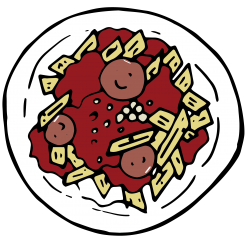Transfer Printing:
Transfer Printing is the transference of an image to fabric or other material via a substrate. Image is then transferred via heat and pressured.
Types of transfer Printing:
– Dry Transfer
– Wet Transfer
– Digital Transfer
Wet Transfer
Wet transfer are a little more expensive transfer method to do at home. Reason being, the ink use for creating the design are a little costly. However, other materials such as paper, baking paper, iron and brush are relatively cheap and easy to be bought. Similar to dry transfer, but this time round, instead of using crayons, it would be replaced by transfer ink. There are also two types of wet transfer, direct and in-direct printing.
Materials Used:
– Fabric
– Transferring Ink
– Items
– Iron
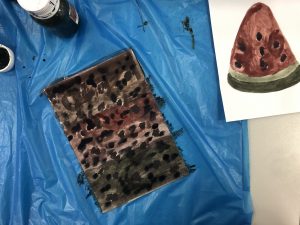
(LAST WEEK) As wet transfer could only be done when the ink are fully dry. Hence, prepping the design would be needed and recommended. Simply used a paint brush and paint your creative design on a normal printing paper and let it sit till it is fully dry. TAKE NOTE: the ink may look different from the colour it suppose to be, but it is alright. The vibrant and accurate colour would be shown once heated:)
*we could actually do the wet transfer using the hot press machine. Sadly it was spoil so we have no choice but to use iron instead:(
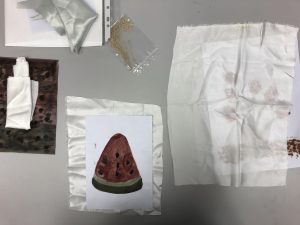
Since it is my first time trying wet transfer, I decided to start off with the most simple design which is the watermelon I drew last week.
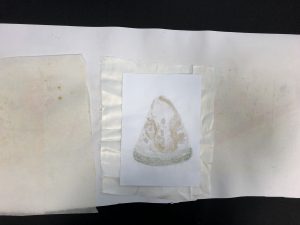
Similar to dry transfer, we place the fabric first on the iron board, followed by our design facing downwards and lastly baking paper on top to prevent burning of the paper.
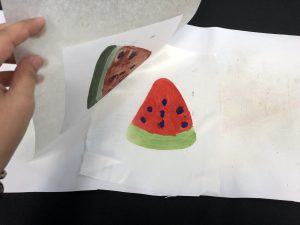
Do remember to constant check your print halfway through ironing to fully get the ink transferred onto to fabric. However, be careful do not shift your design if not once you put it down and iron again the second time your design would not be align.
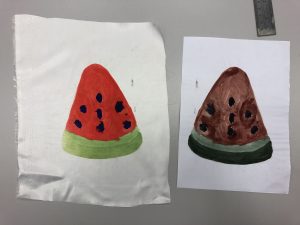
TADA!!! the colour came out really pretty and vibrant. I thought that the black would be more solid however maybe due to heat, it was melted and blend a little with the red. ALSO! looking at my painting on the right I actually diluted the green a little to create a gradient (both are the same green just one a little more water). However, when printed the gradient does not come out. Therefore adding water to create the different colour does not really work. Next time it is recommended to use two different colour, one lighter and one darker.
In-Direct Transfer Printing
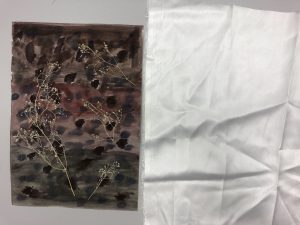
In-Direct Printing is similar to dry transfer. By letting the ink directly be printed onto the fabric surface. However placing patterns on the design, the transferred print would eliminate the places block by the patterns which would come out wide and only print out the places that are not block by the pattern. I found some dry decoration flower at home and home and thought it would be interesting to try it.
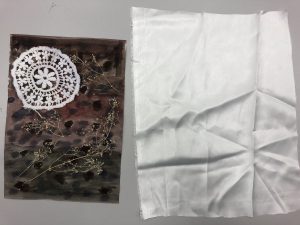
Then Kaie offer me this little fabric coaster like item and I though why not place them all together and try it:)
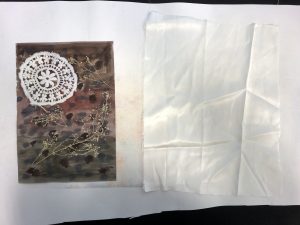
The way to place on the iron board its a little different compared to dry transfer. Because there is items on the design, if we flip it over the items on the design would shift and drop. Therefore we place the design along with the items on the iron board first, followed by putting the fabric ontop then lastly cover it with baking paper and then iron to heat it.
Direct Transfer Printing

Probably because I was using iron instead of hot press machine, therefore it is not tightly compress enough (not enough weight to press the heat onto the design and fabric). Making the in-direct print a little less visible, not really obvious.

After Ironing, because the heat it not heavy enough to compress and press down causing the part block by the fabric coaster became a big white circle instead of the letting the ink transfer through the holes in between the coaster. But instead, alot of ink were transfer onto the fabric coaster instead and I thought “Hey, I could do direct transfer with this!”
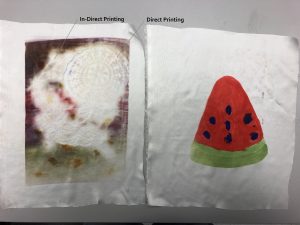
TADA!!!:) the direct printing works:)
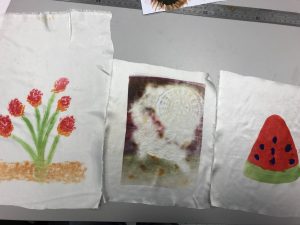
Reflection:
All my wet transfer for the second week!:) It was definitely more fun playing with ink firstly because of the interesting colours it gives out. but also because there are more variety to experiment with. Also touching the ink on the surface it doesn’t create the waxy texture compared to the crayons and crayons do gives out a very strong wax smell especially after heated. Therefore I really love the effect and process of wet transfer.
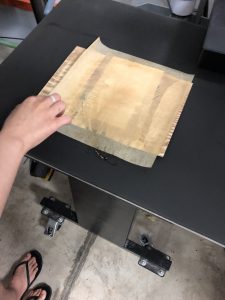
NOTE* If the hot press machine exceed the temperature suitable for specific material it would burn in. Try not to go over 200 especially for fabric.
